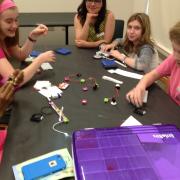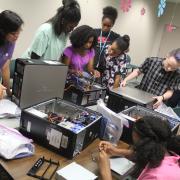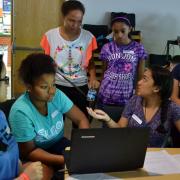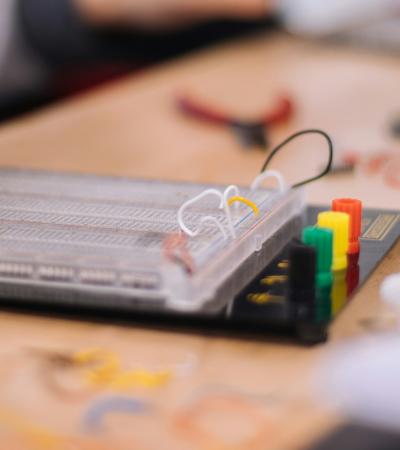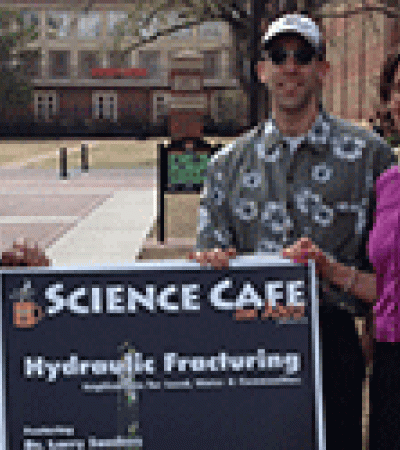Girls in Engineering, Math and Science (GEMS) is a weekly STEM workshop series for teenage girls offered at five of our library system’s locations during the month of June. Participants get to meet influential women in the science, technology, engineering and math (STEM) fields, learn about STEM opportunities and get hands-on experience with STEM technologies.
Each two-hour session consists of a presentation from a female professional in a STEM field, followed by a one-hour activity that explores and builds STEM skills among the participants.
GEMS is an annual program, now in its fourth year, with registration open to a total of 125 girls. In 2017, the program was offered once a week at each location from Monday, June 5, to Monday, June 29.
Advanced Planning
Our goal for this program series is to change knowledge, attitudes and beliefs about women in STEM fields and support girls in their STEM curiosity!
Our planning team consisted of representatives from each of the host libraries, plus two members of our community user engagement department, who handled the administrative aspect of planning. GEMS is offered in June, but due to the scope and popularity of the program we began planning early in the year. Securing speakers for each location and purchasing activity materials are both lengthy processes, so the earlier we start the better! Below is a timeline of our planning process.
- February: Brainstormed ideas for potential speakers and activities. Voted on our favorite activities and drafted program proposals for the top four, including cost of materials.
- March: Contacted potential speakers and, after getting approval from administration, purchased materials. We also drafted potential schedules for each location and reserved program rooms. (View a speaker template letter under Attachments at right.)
- April: Opened online registration for the program and continued to contact potential speakers.
- May: Confirmed speakers for each location, promoted the event and had a “play date” for the team to try out materials bought for the program.
Marketing
In April, we announced that online registration was open with a scrolling banner on our website, which was supported with printed fliers that were posted in all of our branches. (View flier under Attachments at right.) Spots filled up quickly, and by early May, registration was two-thirds full.
To help us reach capacity, our public relations department wrote a short article promoting GEMS, noting that spaces were filling quickly. This was picked up by a local newspaper, which gave us even more exposure. By the end of May all locations except one were at capacity with a waiting list.
Budgeting
Funding for GEMS is generously provided by our Library Foundation, with a budget of about $5,000 per year. Most of that budget is spent on new activity materials; however, the team aims to purchase items that can be reused over and over, with a mind toward building a library of STEM kits that can be reserved and used by all staff for STEM programs across the system after GEMS has concluded.
For example, thanks to past GEMS purchases, we now have transportable kits of Sphero robots, LittleBits and MakeyMakeys. In addition to buying more costly tech toys, we also choose low-cost activities (such as paper circuits) to keep our budget in check.
Speakers also graciously donate their time and skills to help reserve our budget for purchasing materials.
Day-of-event Activity
Set-up for each event depends on the activity and the speaker of the day. A speaker may need a projector or prefer the room to be arranged a certain way, so keeping in contact with speakers prior to the program is important. At least two hours is needed before the event to set up the room for the speaker and prepare the activity materials.
GEMS can be run by one staff member, but not easily. Having at least one other person to assist with the set-up and activity eases a lot of stress! Technological problems will undoubtedly arise, so make sure that each person running the program is sufficiently comfortable with the activities and knows how to troubleshoot any issues.
Unexpected challenges — such as speakers canceling at the last minute or tech toys not being charged enough to do an activity — have occurred, so having a backup plan can be a lifesaver. This could be as simple as stretching the planned activity to two hours or pulling up an Hour of Code program online to substitute a speaker or activity.
Program Execution
In 2016, 116 girls registered and 85 of them attended at least one session; 2017 currently has 120 girls registered. Preparing for GEMS is a lot of work, but it is so worth it to see how excited the girls get about the activities!
Before dissecting the insides of computers in 2016, the girls at my location were hesitant, afraid to “mess it up.” When I told them it didn’t matter if they couldn’t get the computers to work again, their faces lit up with glee and they dove in fearlessly with their screwdrivers to take them apart. A librarian at another location shared that one of the girls was so inspired by an entrepreneurial activity presented by guest speakers that she started her own cupcake business online!
Stories like this are the dream goal of GEMS. We hope to give teenage girls the tools, space and opportunity to explore and be comfortable in pursuing STEM activities and careers. We hope by participating in these activities, they will be bold and confident as they make strides into their adult lives, no matter where their path leads them. Many girls return year to year, which we hope means we have achieved our goal!
Because of supplies bought for GEMS, we now have several STEM kits that are used across our whole system, and we have been able to offer many more high-quality STEM programs for all ages, both in our branches and at outreach events.
Starting in 2016, we’ve begun hanging out a pre- and post-questionnaire to GEMS participants to measure whether or not their attitudes and/or beliefs about STEM change after participating in our workshop. 2016’s data were inconclusive. (View the 2017 pre-questionnaire under Attachments at right.)
Advice
You don’t have to be a large library system, or even have a huge budget, to make this program work for you. The first year of GEMS was held at one location and had about a third of the budget we have now. You can cut costs by choosing cheap STEM activities and seeking out educator discounts on tech toys — and don’t forget that presenters will likely have cool tech to share, too!
Seek out presenters from nearby universities, local businesses and government, and look to personal connections to find presenters as well. We have had the great luck to work with a group called Women in Technology (WIT) every year of GEMS. Search around to see if there are any women in STEM organizations close to you that you could partner with.
One last word of advice: plan as early as you can!
Supporting Materials
- Feedback (Coming Soon!)
- Programming Librarian Facebook Group

